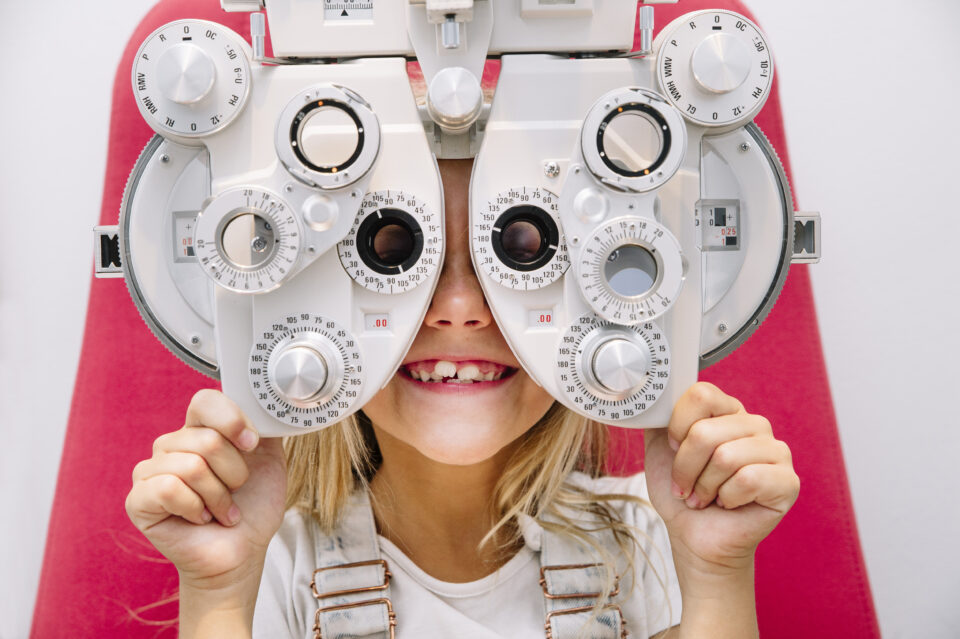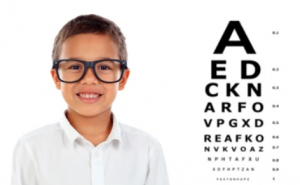
Wiggle Room – Childhood Vision Exams and Screenings
March 1, 2021
When it comes to a child’s health, vision is an aspect often overlooked by parents.
Even though children get quick vision screenings in their pediatrician’s office during regular health check-ups, these are not sufficient to fully gauge ocular health and milestones.
Eye exams
 The American Optometric Association recommends that every child should have their first eye exam prior to 12 months of age. This standard is to ensure that the eye is healthy, the child’s vision is on the right track, and there are no hidden problems. If there are no problems, the next eye exam should be at three years, and then again at age five.
The American Optometric Association recommends that every child should have their first eye exam prior to 12 months of age. This standard is to ensure that the eye is healthy, the child’s vision is on the right track, and there are no hidden problems. If there are no problems, the next eye exam should be at three years, and then again at age five.
While these exams may seem to come early in a child’s life, they are crucial to ensure healthy development of the visual system. By the time a child reaches three years of age, their visual system is halfway through maturity and development, continuing to develop up to six years of age.
If certain vision problems are not caught early enough, the odds of successful treatment significantly decrease and risk of long-term vision problems increase. Among the problems that can occur is amblyopia, or “lazy eye.” This occurs due to poor focusing and lack of use in an otherwise normal eye. If caught in a vision exam and treated early (by glasses, surgery or other means), chances of improvement are excellent.
The American Academy of Pediatricians’s parental website healthychildren.org is a good online resource for parents. Among their pages are lists of specific eye problems children may develop, and visual warning signs and symptoms of which parents should be aware.
What About Vision Screenings?
Vision screenings done in a pediatrician’s office are not eye exams, and typically only catch 10% of vision issues. Also, vision screenings cannot catch problems like astigmatism or far-sightedness.
A pediatric optometrist has pediatric tools that are specifically designed for the young child. Using tools such as a retinoscope and age-appropriate assessment tools, allows the eye doctor to provide an accurate eye assessment, regardless of age or ability.
If a child is struggling in school, the first thing that should be checked is their vision. Sixty percent of children who experience learning difficulties have an undiagnosed vision problem. When looking at the typical school age population, one in four children have an undiagnosed vision problem.
Keeping Your Child’s Eyes Healthy
 Minimizing screen time is extremely important for vision and eye health, as screen time has been proven as a trigger for nearsightedness. The suggested rule of thumb for children’s screen time is 20 minutes on and 20 minutes off for children under the age of 6 years; 45 minutes on and 20 minutes off for children 6 years and older. And when the child is off of the screen, they should be engaging in physical activity.
Minimizing screen time is extremely important for vision and eye health, as screen time has been proven as a trigger for nearsightedness. The suggested rule of thumb for children’s screen time is 20 minutes on and 20 minutes off for children under the age of 6 years; 45 minutes on and 20 minutes off for children 6 years and older. And when the child is off of the screen, they should be engaging in physical activity.
All said, the earlier, the better to get your child’s vision checked by a pediatric eye doctor, as early detection of vision problems can significantly decrease the chances of long-term vision problems.
A special thank you to Dr. Katie Kimle Wonch, pediatric optometrist at Infinite Vision, who provided valuable information for this article via interview.
 Kimberly Bradley, MS, LOTR, is a pediatric occupational therapist and owner of Kim4Kids.
Kimberly Bradley, MS, LOTR, is a pediatric occupational therapist and owner of Kim4Kids.

